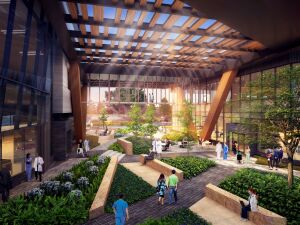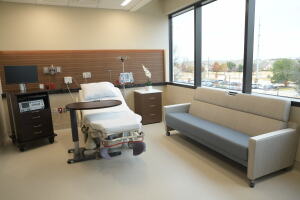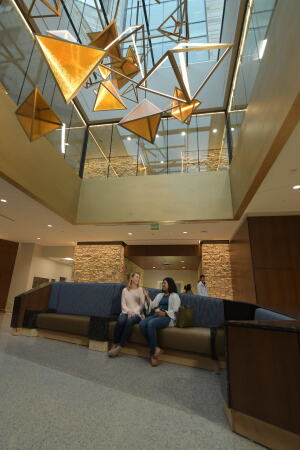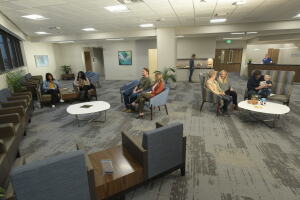Q&A with Brett Lee, president of Texas Health Frisco
April 24, 2020
by Sean Ruck, Contributing Editor
For this month’s installment, we turn to the Lone Star State, where we spoke with Brett Lee, president of Texas Health Frisco, to learn more about him, the newly opened hospital and how it all came about.
HCB News: What inspired you to follow a career in healthcare?
Brett Lee: I’d say I’m a healthcare lifer. My parents are both clinicians. I grew up in a small town in Oklahoma where I started as a volunteer in a hospital when I was 12. I’ve worked for a hospital or healthcare organization every year since, first as a physical therapist and now as an administrator.
HCB News: When you were treating patients, did your parents ever throw out advice? Or were you ever touching base with them about professional matters?
BL: Absolutely! Any clinician or leader has their Mount Rushmore of people as sounding boards and my parents are definitely on that list. I really value their opinion, because they’ve been practicing for years. I bounced ideas off of them on how to approach a new program or an issue with our teams here in Frisco, and I think their guidance has been outstanding. You get a very unfiltered perspective of how your actions would be perceived by those who are actually doing the work.
HCB News: How long have you been with Texas Health Frisco?
BL: I’m pretty new. I’m approaching a year. I joined in April of last year to bring the project to fruition.
HCB News: What influenced your decision to join the team?
BL: It was really a lot of different factors that came together to make this the perfect fit. I have known the leadership at Texas Health for years. I’ve always held them in high regard. When the opportunity to create a brand new clinical platform in the fastest-growing area in the Dallas/Fort Worth Metroplex arose — the chance to blend the very best of a world-class academic medical center with a world-class, faith-based and community-focused health system into a unique care delivery platform that’s really unlike anything else that exists here — those were things that were just too good to pass up.
HCB News: From a staff perspective, what do you think the hospital is best known for?
BL: We are still very new, but what we have is the unique opportunity to create a culture that brings the very best of all the organizations from where our staff are coming from and lay the foundation for an excellent culture. From the very beginning, we have been very inclusive of the staff in terms of how we operationalize the hospital. We had a series of sessions with our staff and clinician partners to design all the workflows that would go into this hospital. We had two all-day mock patient events where we tested those workflows and continued to develop them with our staff. Our strategic plan was developed with input of folks from within the community. We have really emphasized that we equally value outstanding care and clinical outcomes, and the creation of a warm and welcoming environment. We have implemented daily rounds and daily safety huddles with our leadership team where we go out and interact with our staff and talk about our key performance indicators and how we improve.
We also have engaged the Ritz-Carlton to help us in creating a culture of service here that emphasizes a customer experience where we get to know our patients and patient families on a personal level. We understand what’s important to them not only about their health and outcomes, but what’s important about their family. So it’s very much a culture where we’re promoting outstanding care, but also supporting patients and families in a very unique way.
HCB News: Can you give some details about the mock events?
BL: So we spent three months before we opened the hospital with a group of about 100 people in various areas that would be working in the hospital. We also had partners from both our academic as well as community physician groups that helped us look at every process in the hospital — from how you register a patient to what happens if you have a code in the neonatal intensive care unit — to make sure we had a good understanding of how we wanted to respond to each of those issues.
Still, because it’s a new team in a new facility, even though we had the space designed we hadn’t really worked out how we wanted our patients to interact with the space or how we wanted our staff to interact. We felt the only way we could do that without practicing on the first patient who came through the door was to have mock patients come through. So we spent a day in November of 2019 just sending mock patients through about 400 scenarios. We came up with scenarios that tested multiple different workflows and patients with a variety of different health issues that tested different parts of the system. After that first day-in-the-life event, we had a full debrief to discuss what worked and what didn’t. We had about 60 pages of notes that were modifications in the workflow. The second day-in-the-life event occurred about two weeks before opening in early December. It really allowed us to test our system in a way that made us very confident that we could care for that first patient that walked through the door.
HCB News: You mentioned you engaged the Ritz-Carlton — can you explain that relationship?
BL: What we wanted was a real unique experience on this campus. When you spend time here, it doesn’t look and feel like any other hospital I’ve been in. It’s designed to be a space that promotes healing not only from a physical standpoint, but also an emotional one. It takes people who are very stressed due to their need to visit a hospital and helps reduce their stress. So it’s intended not to look or act like a traditional hospital. When you walk through the halls, it very much looks and feels like a hotel. On the campus, we have walking trails. There’s also a park we dedicated in conjunction with the homeowners association next door to us. It’s really intended to be a wellness campus, not just an acute care campus.
We felt that to supplement what we were trying to do with the space design, we really needed people to think differently about what it means to provide good customer service in healthcare. We think that as long as we provide good clinical care, that’s enough. But we wanted our people to go beyond, to learn about our patients personally. What’s important to them? What’s the one thing they want to achieve with us? Not just getting healthy but what do they want to get back to at a personal level and then creating an atmosphere that provides experiences for them to help achieve that goal. We’ve trained our staff in a very granular way as they do in the Ritz-Carlton about how to provide a warm welcome. What do you do when you’re 10 feet away from a patient? What do you do when you’re five feet away that makes them feel welcome? How do you communicate with them in a way that instills confidence in their caregivers? How do you make sure that everyone is thanking them for choosing our service, but also asking what we can do better so that we can get feedback in real time as to how we can improve. We worked with the Ritz-Carlton to create a design team within our own staff who are taking those concepts and putting them into practice in a day-to-day basis.
HCB News: How long was the process from the ideation to open?
BL: The entire process was about three years, but I would say the ideation was not done in isolation. One of the things that Texas Health did very well with this project was engaging the feedback of our neighbors and community to learn about what they wanted in a healthcare campus.
HCB News: Texas Health Frisco touts the environmentally friendly campus. Was that focus something driven by leadership, something in-demand from the community or some other mix?
BL: That’s a great question because I think this is where you really start to see the power and benefit of getting feedback from the community before you build a facility in their backyard. This was absolutely driven by feedback we received from our focus groups. Certain things are very important to our community in Frisco. One is that it’s a very environmentally conscious community. They know intuitively that hospitals are typically big energy drains and wanted to make sure we were being mindful and good stewards of our environment. So that’s where we made decisions around using native Texas landscaping so that we reduced our irrigation needs. We use reclaimed rainwater to make sure we’re reducing water utilization. We have a strong focus on recycling and use building materials that help to reflect the heat to reduce the energy use needed for cooling.
HCB News: What has the community’s reception been?
BL: It has been great and we worked hard for that. We worked with the community on partnerships to support local businesses. So rather than going out and creating another chain coffee shop for instance, we partnered with a local shop to show our dedication to local businesses. We also partnered with local non-profits like Frisco Family Services, which sponsors a food bank. We’re inviting some of their families in need to participate in cooking classes and nutrition education. We’re part of the community and want to be supportive of it and appreciative of that fact.
HCB News: What inspired you to follow a career in healthcare?
Brett Lee: I’d say I’m a healthcare lifer. My parents are both clinicians. I grew up in a small town in Oklahoma where I started as a volunteer in a hospital when I was 12. I’ve worked for a hospital or healthcare organization every year since, first as a physical therapist and now as an administrator.
HCB News: When you were treating patients, did your parents ever throw out advice? Or were you ever touching base with them about professional matters?
BL: Absolutely! Any clinician or leader has their Mount Rushmore of people as sounding boards and my parents are definitely on that list. I really value their opinion, because they’ve been practicing for years. I bounced ideas off of them on how to approach a new program or an issue with our teams here in Frisco, and I think their guidance has been outstanding. You get a very unfiltered perspective of how your actions would be perceived by those who are actually doing the work.
HCB News: How long have you been with Texas Health Frisco?
BL: I’m pretty new. I’m approaching a year. I joined in April of last year to bring the project to fruition.
HCB News: What influenced your decision to join the team?
BL: It was really a lot of different factors that came together to make this the perfect fit. I have known the leadership at Texas Health for years. I’ve always held them in high regard. When the opportunity to create a brand new clinical platform in the fastest-growing area in the Dallas/Fort Worth Metroplex arose — the chance to blend the very best of a world-class academic medical center with a world-class, faith-based and community-focused health system into a unique care delivery platform that’s really unlike anything else that exists here — those were things that were just too good to pass up.
HCB News: From a staff perspective, what do you think the hospital is best known for?
BL: We are still very new, but what we have is the unique opportunity to create a culture that brings the very best of all the organizations from where our staff are coming from and lay the foundation for an excellent culture. From the very beginning, we have been very inclusive of the staff in terms of how we operationalize the hospital. We had a series of sessions with our staff and clinician partners to design all the workflows that would go into this hospital. We had two all-day mock patient events where we tested those workflows and continued to develop them with our staff. Our strategic plan was developed with input of folks from within the community. We have really emphasized that we equally value outstanding care and clinical outcomes, and the creation of a warm and welcoming environment. We have implemented daily rounds and daily safety huddles with our leadership team where we go out and interact with our staff and talk about our key performance indicators and how we improve.
We also have engaged the Ritz-Carlton to help us in creating a culture of service here that emphasizes a customer experience where we get to know our patients and patient families on a personal level. We understand what’s important to them not only about their health and outcomes, but what’s important about their family. So it’s very much a culture where we’re promoting outstanding care, but also supporting patients and families in a very unique way.
HCB News: Can you give some details about the mock events?
BL: So we spent three months before we opened the hospital with a group of about 100 people in various areas that would be working in the hospital. We also had partners from both our academic as well as community physician groups that helped us look at every process in the hospital — from how you register a patient to what happens if you have a code in the neonatal intensive care unit — to make sure we had a good understanding of how we wanted to respond to each of those issues.
Still, because it’s a new team in a new facility, even though we had the space designed we hadn’t really worked out how we wanted our patients to interact with the space or how we wanted our staff to interact. We felt the only way we could do that without practicing on the first patient who came through the door was to have mock patients come through. So we spent a day in November of 2019 just sending mock patients through about 400 scenarios. We came up with scenarios that tested multiple different workflows and patients with a variety of different health issues that tested different parts of the system. After that first day-in-the-life event, we had a full debrief to discuss what worked and what didn’t. We had about 60 pages of notes that were modifications in the workflow. The second day-in-the-life event occurred about two weeks before opening in early December. It really allowed us to test our system in a way that made us very confident that we could care for that first patient that walked through the door.
HCB News: You mentioned you engaged the Ritz-Carlton — can you explain that relationship?
BL: What we wanted was a real unique experience on this campus. When you spend time here, it doesn’t look and feel like any other hospital I’ve been in. It’s designed to be a space that promotes healing not only from a physical standpoint, but also an emotional one. It takes people who are very stressed due to their need to visit a hospital and helps reduce their stress. So it’s intended not to look or act like a traditional hospital. When you walk through the halls, it very much looks and feels like a hotel. On the campus, we have walking trails. There’s also a park we dedicated in conjunction with the homeowners association next door to us. It’s really intended to be a wellness campus, not just an acute care campus.
We felt that to supplement what we were trying to do with the space design, we really needed people to think differently about what it means to provide good customer service in healthcare. We think that as long as we provide good clinical care, that’s enough. But we wanted our people to go beyond, to learn about our patients personally. What’s important to them? What’s the one thing they want to achieve with us? Not just getting healthy but what do they want to get back to at a personal level and then creating an atmosphere that provides experiences for them to help achieve that goal. We’ve trained our staff in a very granular way as they do in the Ritz-Carlton about how to provide a warm welcome. What do you do when you’re 10 feet away from a patient? What do you do when you’re five feet away that makes them feel welcome? How do you communicate with them in a way that instills confidence in their caregivers? How do you make sure that everyone is thanking them for choosing our service, but also asking what we can do better so that we can get feedback in real time as to how we can improve. We worked with the Ritz-Carlton to create a design team within our own staff who are taking those concepts and putting them into practice in a day-to-day basis.
HCB News: How long was the process from the ideation to open?
BL: The entire process was about three years, but I would say the ideation was not done in isolation. One of the things that Texas Health did very well with this project was engaging the feedback of our neighbors and community to learn about what they wanted in a healthcare campus.
HCB News: Texas Health Frisco touts the environmentally friendly campus. Was that focus something driven by leadership, something in-demand from the community or some other mix?
BL: That’s a great question because I think this is where you really start to see the power and benefit of getting feedback from the community before you build a facility in their backyard. This was absolutely driven by feedback we received from our focus groups. Certain things are very important to our community in Frisco. One is that it’s a very environmentally conscious community. They know intuitively that hospitals are typically big energy drains and wanted to make sure we were being mindful and good stewards of our environment. So that’s where we made decisions around using native Texas landscaping so that we reduced our irrigation needs. We use reclaimed rainwater to make sure we’re reducing water utilization. We have a strong focus on recycling and use building materials that help to reflect the heat to reduce the energy use needed for cooling.
HCB News: What has the community’s reception been?
BL: It has been great and we worked hard for that. We worked with the community on partnerships to support local businesses. So rather than going out and creating another chain coffee shop for instance, we partnered with a local shop to show our dedication to local businesses. We also partnered with local non-profits like Frisco Family Services, which sponsors a food bank. We’re inviting some of their families in need to participate in cooking classes and nutrition education. We’re part of the community and want to be supportive of it and appreciative of that fact.






